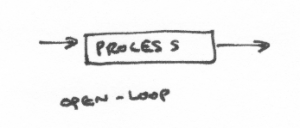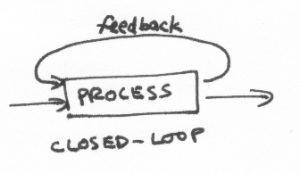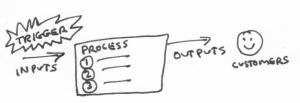Ban open-loop processes!
“We’re having another status meeting? I still haven’t done the work assigned to me at the last status meeting!”
The world literally runs on processes. Driving to work, buying groceries, calling your friends, typing a blog entry, or reading a book are all processes.
There are many different words for processes, and little standardization. (Often different words–such as “value stream,” “procedure,” or “standardized work instruction”–are used to indicate the scope, hierarchy, or level of detail of a given process.)
Although processes are everywhere, people often aren’t consciously aware that they’re “in” a process. Which is too bad, because there are some really simple tools to improve the process. I’m going to talk about one simple way to improve processes: turn open-loop processes into closed-loop processes.

An open-loop process is a process that does NOT learn from itself. For example, if you attend a recurring status meeting, but each meeting seems to ignore whatever happened at the previous meetings, that’s an open-loop process. As another example: each week you keep getting asked what you’re doing, although you were very clear that you were fully committed for the next four weeks.
Open-loop processes are almost always evil. Whenever possible, they should be banned.

A closed-loop process is a process that learns from itself. For example, if you attend a recurring status meeting that’s split into “old business” and “new business” and you review what was discussed at the last meeting in the “old business” section before moving on to “new business,” then the meeting has learned from itself. Or, better yet, at the last meeting they recognized you were fully committed for the next four weeks and therefore you were made an optional attendee until your scheduled work is complete.
Closed-loop processes enable the feedback needed for process improvement.
Open-loop processes are evil because they never get better, or learn from their mistakes. Think Albert Einstein’s famous quote: “Insanity is doing the same thing, over and over again, but expecting different results.” Open-loop processes don’t notice the results.
Open-loop processes are also evil because people tend to have an intrinsic motivation to make things better, and open-loop processes rarely provide a space for people to make things better.
If there’s only one improvement you can make to an open-loop process, it’s to make it into a closed-loop process. That way the process can start learning from itself and you create more opportunities for future improvement.
Aside: What is a process?

What makes the word “process” valuable? Why don’t we just say people “do stuff” and be done with it?
The term “process” is helpful because it lets us analyze what we do. Processes have common characteristics. If you’ve been through ITIL Foundations training or have any experience with process definition, this should be old hat to you. Processes have…
- Triggers–things that make the process begin. If you were going to the ATM and you put your debit card in the ATM, that was the trigger for starting your ATM transaction.
- Inputs–stuff that’s needed for the process. With the ATM, you need your card but also your PIN, and an ATM. For withdrawals, you need money in the account; for deposits, you need whatever you’re going to deposit.
- Activities–ordered steps in the process. For example:
- you put in the ATM card,
- you type in your PIN,
- the ATM validates your PIN and account,
- you hit “withdraw,”
- you type the amount,
- the ATM gets your list of accounts,
- you say the account,
- the ATM checks the balance and debits your account, and finally
- the ATM gives you money.
- Outputs–stuff the process creates, both explicitly and as a side-effect of the process. With the ATM, you will get your ATM card back, plus any money you withdrew, plus a receipt. Your bank account will also be updated.
- Customers–consumers of the process–the people affected as downstream stakeholders. In the ATM example, this is you, your bank, and any intermediary stakeholders (e.g. if you used a different company’s ATM).
What are the signs of an open-loop process?
To make an open-loop process into a closed-loop process, you need to be able to recognize open-loop processes. Here are indicators of an open-loop process:
- What happens to the process outputs? Are any of the outputs ignored? For example, what happens to any trash generated by the process–is it thrown away? If any outputs are ignored, it’s likely the process is open-loop.
- When was the last time anyone checked to see how well this process was performing? If no one has checked, it’s likely the process is open-loop.
- Are any data available to measure the performance of this process? If no data is available, it’s likely the process is open-loop.
- Are the process triggers affected by the process performance or outputs? (Think to the ATM example–you wouldn’t try to withdraw more money from an ATM if you’ve already withdrawn all your money.) For example, if you’re having weekly planning meetings, are they cancelled if everyone has enough work planned?
How do you “close the loop” on an open-loop process?
Once you’ve found an open-loop process, how do you “close the loop”?
First, consider who owns the process. Who is accountable for this process–who defines the process or signs off on any process changes? They need to be involved.
Second, is there a way for you to check your assumptions and validate the process is open-loop? You might be able to do this by talking with someone else involved in the process. DANGER: you should check your assumptions in a way that is positive and does not undermine the process or its owner(s).
Third, what would you propose be changed to make the process closed-loop? Unfortunately, although this is a pretty important step I can’t give you much general-purpose advice, except to look at the process outputs and consider how they might be used the next time the process runs–e.g. in a meeting approving new work, reviewing a report on how much work has already been approved.
Fourth, what would be a good way to take your idea to the process owner? DANGER: your feedback needs to be perceived as helpful and team-building, taking into account a host of things. I can’t give you much general-purpose advice here either; I’d have to talk with you on a case-by-case basis. However, having a recommendation in hand (the previous step) shows you aren’t trying to give them more work to do, and if you don’t involve your ego you could be seen as an ally for the process owner.
For the previous two steps, the books Crucial Conversations and How to Win Friends and Influence People are both helpful.
Examples of open-loop processes, and how to make them closed:
- Spending money without knowing how much money is left. (You don’t see how the money you spend affects the ability to spend money later.) Solution: find out how much money is available first, and/or what other spending is expected.
- Creating a help desk ticket for a user without checking their ticket history. (This may be the user’s fifth ticket today.) Solution: check the history or at least ask the user.
- Building any artifact (e.g. a project charter) from a blank document. (You may forget a needed field, or someone may have had a great idea for how to improve that type of artifact but you don’t know about it.) Solution: at least create a template and review the template from time to time. Ideally, record common “snippets” to be re-used.
- Drawing something from scratch on a white board, when that drawing has been made before. (The previously-created knowledge was not captured, or you may mis-remember the drawing.) Solution: take a picture or use a knowledge base to capture the information so it can be re-used or improved upon.
- Customers requesting new work. (Customers ask for new things without taking into account what they or others have already requested.) This is a tricky one. Example solutions: charge for service or have governance/administrators select and/or prioritize the work to be done based on existing workload.
Why are open-loop processes created in the first place?
This part is less immediately helpful and more philosophical.
Open-loop processes often are created in a period of abundance, when you don’t need to be efficient. For example:
- United States logging in the 1800s: there were so many trees that reforestation was unnecessary for loggers. There were always new forests.
- Baggage charges for flying: fuel was inexpensive enough and/or there was enough profit in air travel that it was not necessary to charge for bags. (Charging for bags creates a closed-loop process where passengers now have some incentive not to bring bags.)
- IT in the 1970s-2000s: in many circumstances, IT was seen as equivalent to magic. People will pay a lot for magic. IT is now less often perceived as magic.
Also, open-loop processes are created when organizations don’t understand or value process improvement. It usually takes an extra step to make a process closed, so open-loop is the “default” for new processes.
The good news is, you can help your organization develop a culture of process improvement! You, and only you in your organization, can create this culture of process improvement. Outside consultants can’t do it, although we can certainly help.